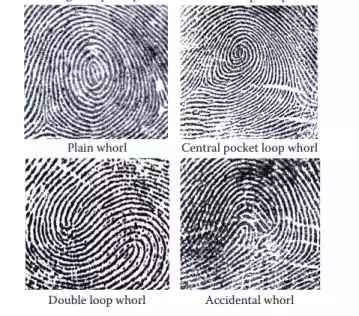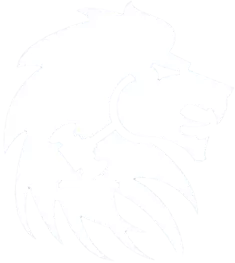This section contains MCQs from Chapter 13 Part 1: Fingerprints from Forensic Science Book By Nordby, James, and Suzanne.
Note: Check more MCQs chapter-wise from the Forensic Science book by Nordby, James, and Suzanne.
1. What are the features of fingerprints that make them suitable for personal identification?
- Their unique patterns and the ability to change over time
- Their unique patterns and permanence throughout a person’s lifetime
- The presence of friction ridges and their genetic basis
- Both (2) and (3)
Answer and Explanation
Answer: (2) Their unique patterns and permanence throughout a person’s lifetime
Explanation:
-> Every fingerprint is unique.
-> Fingerprint does not change during their lifetime unless they are damaged to the dermal skin layer.
2. Why do identical twins have different and distinguishable fingerprints?
- The basic shapes of the patterns and ridges are not determined solely by genetics.
- They have different friction ridge skin patterns.
- They have different genetic make-up.
- Both (1) and (2)
Answer and Explanation
Answer: (4) Both (1) and (2)
Explanation: Although an individual’s genetic makeup probably plays a part in determining the sizes and basic shapes of the patterns and ridges, it is not the only factor.
3. Hills and valleys on the friction ridge skin called
- Hills: Ridges, Valleys: Furrows
- Hills: Furrows, Valleys: Ridges
- Hills: Grooves, Valleys: Depressions
- Hills: Peaks, Valleys: Troughs
Answer and Explanation
Answer: (1) Hills: Ridges, Valleys: Furrows
Explanation: The hills are called ridges and the valleys are called furrows.
4. Which of the following organizations is associated with the field of fingerprint identification?
(a) International Association for Identification
(b) Scientific Working Group on Friction Ridge Analysis, Study and Technology (SWGFAST)
(c) Global Fingerprint Database
(d) Forensic Science Society
Choose the correct option from the list:
- (a) and (b)
- (b) and (c)
- (b) and (d)
- (c) and (d)
Answer
Answer: (1) (a) and (b)
5. Which among the following are the most complex fingerprint pattern?
- Arch
- Loop
- Whorl
- Delta
Answer and Explanation
Answer: (3) Whorl
Explanation:
-> Whorl patterns are the most complex of fingerprint patterns.
-> There are several whorl categories, such as a central pocket, double loop, and accidental.

6. What are the two definable features in loop and whorl patterns?
- Core and radius
- Core and delta
- Ulna and delta
- Radius and ulna
Answer and Explanation
Answer: (2) Core and delta
Explanation:
-> Loop and whorl patterns contain definable features called the core and the delta.
-> Loops have one core and one delta.
-> Whorls have at least one core and 2 deltas.
7. What are the three ways ridges of a fingerprint form minutiae?
- Delta, core, and dot
- Delta, core, and island
- Ending ridge, bifurcation, and dot
- Ending ridge, bifurcation, and island
Answer and Explanation
Answer: (3) Ending ridge, bifurcation, and dot
Explanation: When single ridges form minutiae by:
-> Ending abruptly (ending ridge)
-> Splitting into two ridges (bifurcation), or
-> Being short in length like a punctuation mark at the end of a sentence (dot).
When there is a combination of these minutiae they form distinctive details.
-> Example: when two bifurcations facing each other form island.

8. Which European is often credited with being the first to recognize the value of fingerprints as a means of personal identification?
- Alphonse Bertillon
- Francis Galton
- Sir William Herschel
- Johann Caspar Lavater
Answer and Explanation
Answer: (3) Sir William Herschel
Explanation:
-> Sir William Herschel, a British administrator in India, is often credited with being the first European to recognize the value of fingerprints as a means of personal identification in 1853.
9. What was the primary purpose of Sir William Herschel’s use of fingerprints?
- Art authentication
- Controlling fraud in contracts
- Identifying missing persons
- Criminal investigations
Answer and Explanation
Answer: (2) Controlling fraud in contracts
Explanation: Sir William Herschel developed the use of fingerprints as a means of controlling fraud in contracts, false impersonations in government pension distributions, and other matters.
10. Which country had evidence of fingerprint recognition hundreds of years before Sir William Herschel?
- Egypt
- Greece
- Rome
- China
Answer and Explanation
Answer: (4) China
Explanation: There are records of using fingerprints and handprints as marks of authenticity in China at least 2000 years ago.
11. Over what period did Sir William Herschel demonstrate the persistence of ridge patterns in fingerprints?
- 10 years
- 25 years
- 50 years
- Lifetime
Answer and Explanation
Answer: (3) 50 years
Explanation: Sir William Herschel demonstrated the persistence of the ridge patterns in his own fingerprints taken periodically over a period exceeding 50 years.
12. Dr. Henry Faulds was _________ by training and profession before he went to India as medical missionary in 1871.
- Scottish Archaeologist
- Scottish physician
- Scottish psychiatrist
- Scottish chemist
Answer and Explanation
Answer: (2) Scottish physician
Explanation: Dr. Henry Faulds, a Scottish physician by training and profession, went to India as a medical missionary in 1871 before traveling to Japan in 1872.
13. What important discovery did Dr. Henry Faulds make about fingerprints around 1880?
- They can be used for personal identification.
- They are more reliable than anthropometric measurements.
- They cannot be altered or removed.
- They can be classified, and ridge detail is unique.
Answer and Explanation
Answer: (4) They can be classified, and ridge detail is unique.
Explanation: Around 1880, Faulds noted that fingerprints could be classified, and that ridge detail is unique.
14. To whom did Dr. Henry Faulds write a letter regarding fingerprints in 1880?
- Sir William Herschel
- Charles Darwin
- Francis Galton
- Albert Einstein
Answer and Explanation
Answer: (2) Charles Darwin
Explanation:
-> Dr. Henry Faulds wrote a letter to Charles Darwin in 1880, discussing his observations about fingerprints.
-> Darwin then forwarded the letter to Francis Galton.
15. In which British journal did Dr. Henry Faulds publish his observations on fingerprints in 1880?
- Nature
- The Lancet
- The Royal Society
- British Medical Journal
Answer and Explanation
Answer: (1) Nature
Explanation: Dr. Henry Faulds recorded many of his observations on fingerprints in a letter to the British journal Nature in 1880.
16. Who was in dispute with Dr. Henry Faulds over the priority of fingerprint use as a means of personal identification?
- Charles Darwin
- Francis Galton
- Sir William Herschel
- Louis Pasteur
Answer and Explanation
Answer: (3) Sir William Herschel
Explanation:
-> There was some dispute between Faulds and Herschel over the priority of fingerprint use as a means of personal identification.
-> However, it is fair to say that Herschel and Faulds were very influential in introducing the idea of fingerprints to continental Europe in the later 19th century
Jump to the main page of MCQs from the Forensic Science book by Nordby, James, and Suzanne.

Please review the year in given explanation of Q.12 .
The answer is correct. However, the option number was incorrect. I also add additional information in the explanation to make it more clear. You can reference the answer to Pg. 332. Nordby Book
Dr Henry Faulds died in march 1930. Then how he went Japan in 1972 ??Please review again your the explanation of Q. 12.
Thank you!
Yes, you’re correct. We made a mistake. It is 1872 not 1972. Correction is made.